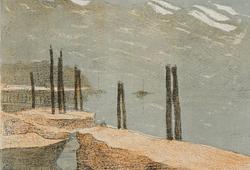Akseli Gallen-Kallela
"The lair of the lynx"
Signed Gallen-Kallela and dated 1906. Canvas 60 x 40 cm.
Alkuperä - Provenienssi
Dr. Arno Saxén (1895-1952), Helsinki.
Then by descent to present owner.
Muut tiedot
In August 1903, the frescos in the Jusélius mausoleum in Pori in Finland were complete. Axel Gallén (from 1907 onwards Akseli Gallen-Kallela) had been working on them for three years. Despite the work being without compare in Finnish fresco painting, following its completion, an artistic vacuum arose and the lack of commissions led to the artist being weighed down by melancholia and financial problems the following year. Furthermore, it became clear that the mausoleum frescoes were more fragile than anticipated and only a year after their completion, some of them had suffered serious damage, which was naturally a blow to both the client and the artist.
Amidst these setbacks, Gallén was in great need of a change of scene and using the fee from the mausoleum and various grants, he travelled via Stockholm, Copenhagen and Berlin to Vienna, where he attended the Wiener Sezession. He was well received, forged numerous contacts in artistic circles and received constant invitations to parties and events. After a few months, however, carefree city life had taken its toll and his wife Mary received a telegram bearing the words: “If you do not come here, I will come home.”
Mary shortly arrived in Vienna and the couple travelled on to Milan, the Riviera, Monte Carlo and Spain. In Malaga the artist contracted malaria and once he was sufficiently recovered, the journey continued to Paris, after which the couple returned, tired and homeless, to Finland in May 1904.
After this hectic and strenuous time, they were both in need of physical and mental rest, and so that summer they hired Lintula farmhouse in Konginkangas in central Finland. Here the artist found the inner peace he had long been seeking; all he wanted was to sit and paint the details of the natural world and pretend he was a schoolboy again. The idyllic summer and the atmosphere of rural life produced peaceful paintings depicting the shoreline at Lintula, the rye fields beside the lake and the water in moonlight. These are counterbalanced by subjects of a different type: slash and burn woodland and storm-felled and broken, strange-shaped trees. The light, soft summer paradise also had its gloomier and darker side.
In early 1905, the Galléns moved to the Pirtti building on Erottaja Square in central Helsinki, where the artist also had a studio. City living also meant taking a step into the artist community, including attending art evenings spanning a range of types of art. In autumn 1905, Gallén was drawn into politics. The anti-tsarist movements in Russia were also reaching Finland, then a Russian Grand-Duchy, and Gallén was actively involved; a natural move for him as he had been a figurehead for national cultural policy as early as the 1890s. Gallén’s home was a first staging post for Russian revolutionaries making their way west, and at times the flat was filled to bursting point with political refugees. They kept rifles under the beds and an eye always had to be kept out for the Russian gendarmes, the security police, who were keeping the flat under observation. One frequent guest was the author Maxim Gorky who Gallén depicted on several occasions.
Despite the worthy effort of providing a home for political refugees, Pirtti was lacking in peace and quiet to work and when the revolutionaries started to hatch increasingly wilder plans, in the late winter of 1906, Gallén fled to Konginkangas, where he and the sharpshooter Pero and another man went to hunt lynx. Pero describes Gallén as the original of a kind of Finnish character, swearing like Beelzebub himself, but so beautifully that it was enjoyable. The hunt was unsuccessful but the comradeship and the magnificent setting gave Gallén great satisfaction. The healthy outdoor exercise and the long ski trips are reflected in his paintings of the area, including in the various versions of Logrottan and the detailed studies of it. The artist’s sense of physical wellbeing is reflected in the imagery and fresh, daring and confident impressions give rise to a new sense of colour.
“All day from early morning I have spent my time on skis, the only possible means of progress in the rugged terrain that interests me. Have worked like a horse and now feel as healthy as ever.”
In Gallén’s paintings of the lynx’s lair we can see what was, for him, a typical celebration of nature. He wanted the viewer to also gain a sense of its purity, expansiveness and magnificence, as he saw it. The subject was mainly immortalised outdoors in severe cold, which made demands of the artist’s instinctive confidence as a painter and his ability to adapt to the prevailing conditions. These circumstances can be discerned in the paintings’ pared-down expression and immediate directness, fascinating and enchanting.
Taiteilija
Akseli Gallen-Kallela is counted among Finland's most famous artists, born in 1865 in Pori. He studied at the Drawing School of the Finnish Art Society in Helsinki and later at the Académie Julian in Paris. He worked across various art forms such as painting, graphics, illustrations, textiles, architecture, and even designed military uniforms. Akseli Gallen-Kallela's first significant work, 'Old Woman with a Cat,' challenged the ideals of its time and paved the way for realism in Finnish painting.
Gallen-Kallela was primarily known for his paintings and illustrations for the Finnish national epic, 'Kalevala.' In 1900, he executed dome paintings with Kalevala motifs for the Finnish pavilion at the World Exhibition in Paris. His visual language is often described as naturalistic, symbolic, and expressionistic
Lue lisää














































